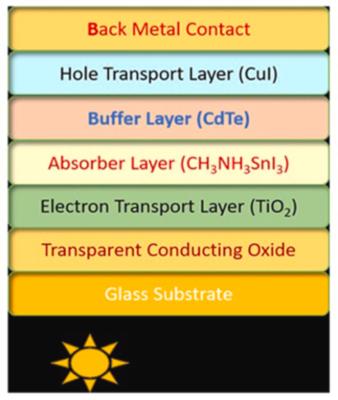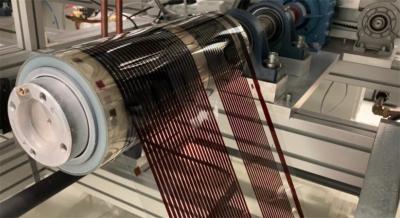Perovskite Solar - Page 11
Researchers rely on homogeneous perovskite crystallization and improved interconnect to achieve efficient perovskite mini-modules
Researchers from the Chinese Academy of Sciences (CAS) posit that the efficiency and stability of perovskite modules are mainly limited by the quality of scalable perovskite films and sub-cells’ lateral contact. So, in their recent work, they addressed this by reporting constant low temperature substrates to regulate the growth of perovskite intermediate films to slow down the crystallization process. This is meant to assist in obtaining high-quality homogeneous perovskite films in large scale size, which avoid the effect of the ambient temperature on the film quality.
Schematic diagram of the fabrication process of perovskite films using low-temperature substrate growth (LTSG). Image from Nature Communications
In addition, a scribing step named P1.5 was added before the top function layers deposition, so the diffusion barrier layer can be formed “naturally” at the interconnection interface without introducing any additional materials, which alleviates the diffusion degradation process.
Researchers use a cadmium telluride buffer layer to improve perovskite solar cell performance
Researchers from Pakistan's University of Agriculture Faisalabad, University College of London United Kingdom and The National University of Malaysia have conducted a series of simulations to investigate how a cadmium telluride buffer layer (BL) may help increase efficiency and stability in perovskite solar cells. Their experiment showed that cell efficiency may climb from 11.09% to 23.56%.
Solar cell architecture with BL. Image credit: Results in Engineering
The researchers explained that the presence of a BL in a perovskite cell offers a porous structure that aids in forming the upper hole-transporting layer (HTL), while also preventing the leakage of corrosive additives from the HTL material. “The improvement in the development of HTM layer not only promotes efficient hole transfer and conduction but also restricts charge recombination,” they explained.
SolaEon claims 21.95% efficiency of monolithic perovskite tandem solar cells
SolaEon Technology, a Chinese solar manufacturer, claims that it has achieved a record conversion efficiency of 21.95% on 300mm x 400mm monolithic perovskite tandem solar cells for MPPT.
In October 2023, SolaEon claimed its 1,200 sq. cm. perovskite single-junction solar cell module achieved a 3rd party certified efficiency of 21.63%. In April 2024, SolaEon said its perovskite solar cell module achieved a steady state efficiency of 19.2% based on 1,027.1 c㎡ area. In May 2024, it reportedly achieved a world record conversion efficiency of 29.34% for monolithic full perovskite tandem solar cells.
Rayleigh Solar Tech announces two major stability milestones
Rayleigh solar Tech has announced two significant lifetime stability results. First, a 15cm x 15cm glass solar module exhibited zero degradation after seven months of outdoor testing. Second, a 15cm x 15cm flexible solar module achieved T80 after 1200 hours of damp heat testing.
“Stability is the crux of any perovskite company’s business model” said Rayleigh CTO and Founder, Dr. Sam March. “This is a huge step towards the commercial viability of our perovskite PV. Rayleigh’s all-ambient slot-die coated carbon-based perovskite solar modules are efficient, low-cost, and are stable in the field”, he said.
Researchers at CityU announce the scalable production of printable PSCs
A research team at City University of Hong Kong (CityUHK) has announced a new generation of printable perovskite solar cells that offer higher efficiency and stability, lower cost and scalability, with a minimal carbon footprint. With funding support from the inaugural Research, Academic and Industry Sectors One-plus Scheme (RAISe+ Scheme) of the Innovation and Technology Commission of the HKSAR government, the team aims to establish a pilot production line within 18 months.
The “Scalable Production of Next-Generation High-Performance Printable Solar Cells” project, led by Professor Alex Jen at CityUHK, was awarded RAISe+ funding to commercialize the technology. Professor Jen is a pioneer in developing perovskite solar cells that has achieved, along with his research team at CityUHK, significant milestones in recent years - such as perovskite solar cells that displayed a power conversion efficiency of over 26% in laboratory testing. They also successfully addressed the common stability issues by demonstrating perovskite solar cells with an estimated lifetime of over 20 years through accelerated aging tests, comparable to that of silicon-based cells in the market.
EU’s PEARL project targets flexible perovskite solar cells with carbon electrodes
The EU-funded project PEARL aims to achieve improvements in solar energy technology by incorporating carbon electrodes into perovskite solar cell architectures. This enhancement is expected to lead to reduced material costs, increased device stability, simplified fabrication processes, and significantly lower emissions. The project started on 1st October 2023 and will run 36 months. PEARL receives funding from the European Union’s Horizon Europe research and innovation program.
The project is coordinated by Teknologian Tutkimuskeskus VTT Oy, and includes partners like the Nederlandse Organisatie voor Toegepast Natuurwetenschappelijk Onderzoek TNO, Helmholtz-Zentrum für Materialien und Energie GmbH, Università degli Studi di Roma Tor Vergata, ICIQ, Dycotec Materials LTD, Fraunhofer Institute for Electron Beam and Plasma Technology FEP, Fachhochschule Nordwestschweiz, Saule Spółka Akcyjna and Eni SPA.
China's GCL to invest USD$98 million in tandem silicon/perovskite PV
GCL Technology, one of China’s largest solar panel materials producers, will reportedly invest 700 million yuan (almost USD$98 million) to transition to a more lucrative next-generation technology, as the industry grapples with losses and oversupply.
The Hong Kong-listed company aims to complete the first phase of a 500 megawatt (MW) plant in Kunshan by the middle of next year, for solar modules that combine cells stacked with perovskite and crystalline silicon, according to a statement by Fan Bin, chairman of GCL Perovskite. “The value of the [nascent] perovskite technology lies in the ample room for uplifting its energy conversion efficiency,” he said. “That is why manufacturers are willing to invest in its development.” The future cost of production using the perovskite-silicon technology could be lower than the crystalline silicon technology, he added.
Researchers develop a strain regulation strategy for high-performance, fully textured perovskite/silicon tandem solar cells
Integrating metal-halide perovskites with the industrially textured Czochralski silicon for perovskite/silicon tandem cells shows great promise for low-cost manufacturing and ideal light trapping. However, the conformal growth of high-quality perovskite film on fully textured silicon remains challenging due to the lack of effective regulation of structural evolution and residual strains.
Recently, researchers from Nanchang University, Suzhou Maxwell Technologies, The Hong Kong Polytechnic University, CNPC Tubular Goods Research Institute, Henan Normal University, Southern University of Science and Technology, Chinese Academy of Sciences, City University of Hong Kong, Yunnan University, Harbin Institute of Technology (Shenzhen) and Fudan University reported a strain regulation strategy by forming a 3D/3D perovskite heterojunction at the buried interface through a vacuum-deposition method applicable to pyramidal texture. They found that the strained heterojunction enables high-performance, fully textured perovskite/silicon tandem solar cells that achieve an efficiency of up to 31.5%.
Researchers attempt to achieve efficient silicon/perovskite tandem solar cells with a unique additive to the perovskite precursor solution
Researchers from King Abdullah University of Science and Technology (KAUST) and Marmara University set out to minimize crystal defects and film inhomogeneities in perovskite top cells, to achieve the full potential of monolithic perovskite/silicon tandem solar cells.
In their recent work, the scientists discuss the use of methylenediammonium dichloride as an additive to the perovskite precursor solution, resulting in the incorporation of in situ–formed tetrahydrotriazinium (THTZ-H+) into the perovskite lattice upon film crystallization.
Researchers design unique passivation that enables stable perovskite solar cells with low photovoltage loss
Researchers from The Hong Kong University of Science and Technology, Oxford University and the University of Sheffield have developed a molecular treatment that significantly enhances the efficiency and durability of perovskite solar cells.
A key to the solution was their successful identification of critical parameters that determine the performance and lifespan of halide perovskites. The research team investigated various ways of passivation, a chemical process that reduces the number of defects or mitigates their impact in materials, thereby enhancing the performance and longevity of devices comprising these materials. They focused on the “amino-silane” molecular family for passivating perovskite solar cells.
Pagination
- Previous page
- Page 11
- Next page






